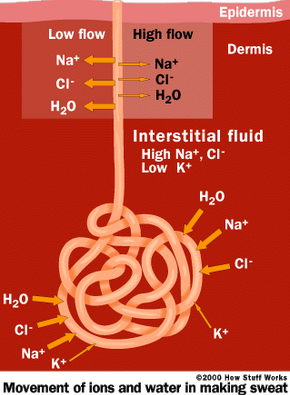How Sweat Is Made
We are constantly sweating, even though we may not notice it. Sweating is your body's major way of getting rid of excess body heat, which is produced by metabolism or working muscles. The amount of sweat produced depends upon our states of emotion and physical activity. Sweat can be made in response to nerve stimulation, hot air temperature, and/or exercise. First, let's concentrate on how sweat is made in an eccrine sweat gland.
When the sweat gland is stimulated, the cells secrete a fluid (primary secretion) that is similar to plasma -- that is, it is mostly water and it has high concentrations of sodium and chloride and a low concentration of potassium -- but without the proteins and fatty acids that are normally found in plasma. The source of this fluid is the spaces between the cells (interstitial spaces), which get the fluid from the blood vessels (capillaries) in the dermis. This fluid travels from the coiled portion up through the straight duct (Figure 2). What happens in the straight duct depends upon the rate of sweat production or flow:
Advertisement
- Low sweat production (rest, cool temperature) - Cells in the straight duct reabsorb most of the sodium and chlorine from the fluid. This happens because there is enough time for reabsorption. In addition, water is reabsorbed osmotically. So not much sweat reaches the outside. Also, the composition of this sweat is significantly different from the primary secretion. There is not as much sodium and chloride, and there is more potassium.
- High sweat production (exercise, hot temperature) - Cells in the straight portion do not have enough time to reabsorb all of sodium and chloride from the primary secretion. So, a lot of sweat makes it to the surface of the skin and the composition is close to, but not exactly like the primary secretion. The sodium and chloride concentrations are about half as much, and potassium is about 20 percent higher.
Sweat is produced in apocrine sweat glands in the same way. However, the sweat from apocrine glands also contains proteins and fatty acids, which make it thicker and give it a milkier or yellowish color. This is why underarm stains in clothing appear yellowish. Sweat itself has no odor, but when bacteria on the skin and hair metabolize the proteins and fatty acids, they produce an unpleasant odor. This is why deodorants and anti-perspirants are applied to the underarms instead of the whole body.
The maximum volume of sweat that a person who is not adapted to a hot climate can produce is about one liter per hour. Amazingly, if you move to a hot climate such as the American desert southwest or the tropics, your ability to produce sweat will increase to about two to three liters per hour within about six weeks! This appears to be the maximum amount that you can produce.
In the next section, we'll learn about why we sweat.
